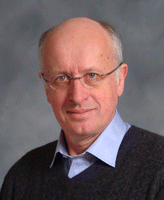An Interview With Gordon Keller
Posted by Eva Amsen, on 19 October 2011
(This interview originally appeared in Development.)
Gordon Keller is Director of the McEwen Centre for Regenerative Medicine at the University Health Network in Toronto, Canada. His research applies concepts from developmental biology to the investigation of the lineage-specific differentiation of mouse and human embryonic stem (ES) cells. He became an Editor of Development in 2011, and recently we asked him a few questions to find out more about him and his research.
 Who or what inspired you to study science?
Who or what inspired you to study science?
I was always curious, and I found a scientific career to be one that allowed me to explore my curiosity.
What sparked your interest to work on the directed differentiation of stem cells?
That was a seminar by Rolf Kemler in 1984. I was in the Basel Institute for Immunology – I had arrived there about a year earlier – and Rolf came to the institute and showed us these beautiful, huge cystic embryoid bodies, in which you could see blood and vascular structures and beating heart cells. Knowing that you could make that from an ES cell piqued my interest and I decided to pursue research in this topic.
What made you return to Canada after having worked in Switzerland and the USA?
There were several things. First, there was an opportunity here to direct the McEwen Centre for Regenerative Medicine. Canada, and Toronto in particular, has a very strong scientific community but also a very strong stem cell biology community. And I am Canadian, and felt it would be a wonderful opportunity to return home and spend part of my career here.
What has been the biggest surprise that you have come across in your research?
I don’t know whether you would call it a surprise, but I have been amazed at the speed at which stem cell research has progressed. We have worked for years at differentiating mouse ES cells, and, although people were interested, it was always somewhat on the back burner. Then the discovery of human ES cells and induced pluripotent stem (iPS) cells transformed the field, and the kind of work we do has now become more mainstream. In a nutshell, I don’t know if I have been surprised by any particular finding so much, but what I find most remarkable is the evolution of the field and seeing it change almost on a weekly basis.
Given these ongoing changes, where do you see the field move next?
I think the biggest challenge that we have is to find a way to get the cells that we make in a dish to integrate into adult tissue and function. We are certainly making components of human tissues and organs, but to date there is not much evidence yet that they are functional, so I think the next hurdle – the big challenge before we can really make an argument that these are clinically relevant cells – is to find out whether in vitro differentiated cells can integrate into adult organ function.
How does developmental biology inform in vitro differentiation?
Developmental biology is the basis of all we do. For the last eight years, we have looked closely at concepts from developmental biology; for example, the pathways that control lineage specification in the early embryo. We initially applied these concepts to mouse ES cells, and more recently to human ES cells. Using knowledge from developmental biology has provided us with a very informed way to develop strategies and protocols that are both robust and efficient.
What is the role of Development within your field?
Many of the key papers that we look at to inform our work have been published in Development, and we have published a lot of our own ES cell work in the journal as well. At times, publishing our work has been challenging, I must say, because when we started it was a new system and a lot of people didn’t believe that cells in a dish could recapitulate development. But Development was very supportive and allowed us an avenue to publish our research.
Is there a particular type of in vitro differentiation paper that you would encourage people to submit to Development?
Absolutely. I would like to see ES cell differentiation papers coming to Development. This could include papers that use the system to study aspects of development that are very difficult to study in an embryo, and there are many examples of that. As we are starting to move from animal models towards human biology, ES cell differentiation is going to be the model for human developmental biology, and I would be delighted if the journal could stake a claim to human developmental biology.
If you were not a scientist, what career would you have chosen?
I have no idea. In fact I’m not sure that I had a priority to start with. I didn’t grow up saying ‘I want to be a scientist’, but rather I followed a path where my thoughts were along the lines of ‘I find this interesting, I’ll pursue it somewhat more’.


 (2 votes)
(2 votes)